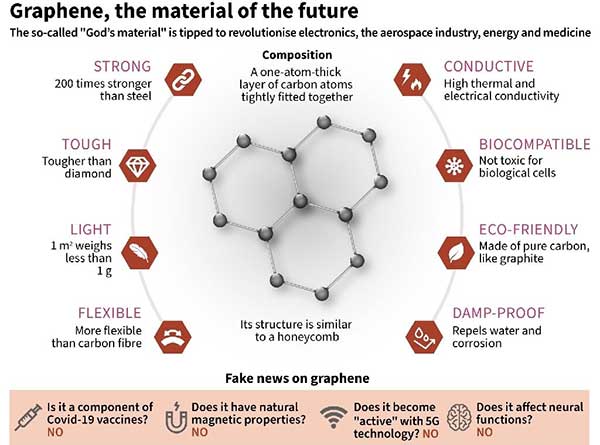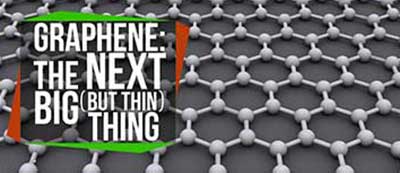Relevance: GS-3: Science and Technology- developments and their applications and effects in everyday life. Awareness in the fields of IT, Space, Computers, robotics, nanotechnology.
Key phrases: Graphene, Application, production, Ocean, Indian Institute of Science, KAS Tech
Why in News?
- A first-of-its-kind centre for studying graphene and developing its newer applications as suitable for industries has recently been approved by the Ministry of Electronics and Information Technology (MeitY).
What is Graphene?
- Graphene is an allotrope of carbon consisting of a single layer of atoms arranged in a two-dimensional honeycomb lattice nanostructure.
- The name is derived from "graphite" and the suffix -ene, reflecting the fact that the graphite allotrope of carbon contains numerous double bonds.
- It was originally observed in electron microscopes in 1962, but only studied while supported on metal surfaces.
- In 2004 the material was rediscovered, isolated and investigated at the University of Manchester, by Andre Geim and Konstantin Novoselov. In 2010 Geim and Novoselov were awarded the Nobel Prize in Physics for their "ground-breaking experiments regarding the two-dimensional material Graphene.
Graphene production in world
- The global graphene market size is projected to grow from USD 620 million in 2020 to USD 1,479 million by 2025, at a CAGR of 19.0%. The graphene industry is growing due to the rise in demand for graphene from various applications, globally. The growth rate for graphene is expected to decline in 2020 due to COVID-19. However, the end of lockdown and recovery in the end-use industries will stimulate the demand during the forecast period.

Why Graphene is important industrial metal?
- Mechanical strength: Graphene is the world's strongest material, and can be used to enhance the strength of other materials. Dozens of researchers have demonstrated that adding even a trace amount of graphene to plastics, metals or other materials can make these materials much stronger - or lighter (as you can use a smaller amount of material to achieve the same strength). Such graphene-enhanced composite materials can find uses in aerospace, building materials, mobile devices, and many other applications.
- Thermal applications: Graphene is the most heat conductive found to date. As graphene is also strong and light, it means that it is a great material for making heat-spreading solutions, such as heat sinks or heat dissipation films. This could be useful in both microelectronics (for example to make LED lighting more efficient and longer lasting) and also in larger applications - for example thermal foils for mobile devices. Huawei's latest smartphones, for example, have adopted graphene-based thermal films.
- Energy storage: Since graphene is the world's thinnest material, it also extremely high surface-area to volume ratio. This makes graphene a very promising material for use in batteries and super capacitors. Graphene may enable batteries and super capacitors (and even fuel-cells) that can store more energy - and charge faster, too.
- The automotive & transportation industry is the largest application industry in the graphene market in terms of volume. The graphene can be used in various applications in automotive industry such as in composite structural components, automotive batteries, tires, anti-breaking systems, among others.
- Graphene has a lot of promise for additional applications: anti-corrosion coatings and paints, efficient and precise sensors, faster and efficient electronics, flexible displays, efficient solar panels, faster DNA sequencing, drug delivery, and more.
- Being a good conductor of electricity and highly flexible, this two-dimensional form of crystalline carbon has enormous number of applications ranging from electronic wearable devices, biomedical devices, sensors, fuel cells, semiconductors, field emission displays, Nano electrodes for inexpensive organic electronic devices such as organic photovoltaic (OPVs), liquid-crystal devices (LCDs), organic light-emitting diodes (OLEDs), super capacitors, fuel cells and batteries.

Challenges to Graphene industry is India:
- The mass production of high-quality and defect-free graphene is still a restraint for all graphene manufacturers as the manufacturing process of graphene is cost-intensive and time-consuming. Maintaining the quality and up-scaling the graphene production at the same time are difficult. In case of any defects on the graphene monolayer carbon network, the properties of graphene such as electrical conductivity, transparency, thermal conductivity, and im-permeability are damaged, which hamper the quality of graphene. For producing high-quality monolayer and few-layer graphene, the CVD process is used, and it is difficult to attend mass production with the CVD process. These factors restrict the mass production of graphene and lead to a higher cost of production.
- Lack of standardisation: The graphene industry is in its initial stage of development, and very little work is done in terms of regulations and standards. Several companies are producing various types of graphene materials, which is causing much diversification and confusion in the industry. This factor has resulted in fake graphene in the market, which is difficult to recognize at the product stage. This is leading to many cases of poor-quality graphene from suppliers and diminishing the trust among end-users.
Way forward:
- Graphene, a form of carbon, is thought to be the material of the future. A sheet of graphene is just one atom thick: millions and millions times thinner than a sheet of paper.
- It is remarkably light, and yet, hundred times stronger than steel, and has extraordinary electrical, thermal, and optical properties.
- In the near future, many novel applications like flexible displays made of graphene, are expected to hit the market. If India wants to ride on the graphene bandwagon, it is imperative that it should find its own ways to manufacture the material.
- 'Ocean', the result of a successful industry-academia collaboration, is definitely a step in the right direction.
- The Government of India should take cognizance of the emerging scenario. Demand within the country is likely to grow rapidly with policy thrust on Make in India. As import dependence for the metal is set to increase, it is necessary to work towards augmenting graphene supplies from a long-term perspective.
Ocean
- Named 'Ocean', the system is a chemical vapour depositor that can produce various two dimensional materials including grapheme.
- Indian Institute of Science and KAS Tech have together developed India's first commercially available, graphene producing system.
- The Centre for Nano Science and Engineering (CeNSE), IISc developed the technology, and working together with KAS Tech, a Bengaluru based manufacturing company, they transformed the lab prototype into a commercial product. The product was launched during the recently held Bangalore INDIA NANO.
Source: Indian Express
Mains Question:
Q. Graphene, often referred to as a "miracle material," is one of the world's strongest materials, and one of the lightest. In this regard discuss the potential applications of Graphene material. What should India do to boost production of Graphene? Critically Analyse.









